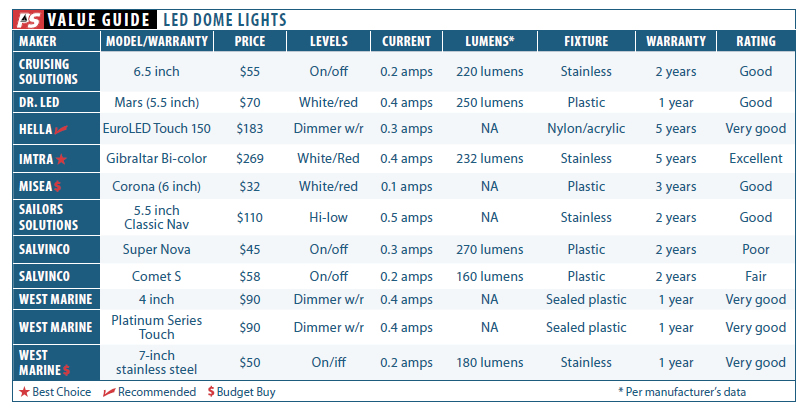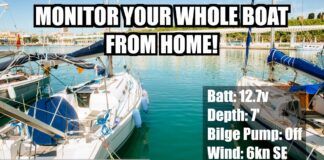Photos by Ralph Naranjo
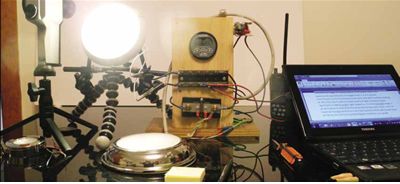
Cabin lighting may lack the drama of setting storm sails and the square-footage splash of an asymmetric spinnaker unfurling, but when it comes to brightening up the interior, and doing the job with fewer amps than ever before, LED cabin lights deserve their own headlines.
In our previous cabin light reviews (PS, May 2010 and January 2009), the transition from incandescent lighting to fluorescent and finally to LED was favorably noted. Since then, the evolution has turned into a solid-state revolution, and LEDs bolstered by dimmers, touch switches, and watertight seals now own the show. And a clean-sweep conversion to LED cabin lighting can knock out the grotto-like ambiance that haunts many sailboat interiors. Often, its not a problem of having too few lights; its an energy shortfall revolving around too few amperes to spare. An LED makeover is also an opportunity to illuminate the lockers, engine room, and other cave-like confines that cause you to reach for a flashlight and wish for an extra hand to hold it. Not only is the timing right to tap into a new genre of energy-efficient lights, but the product range and pricing offer a gameplan for every budget.
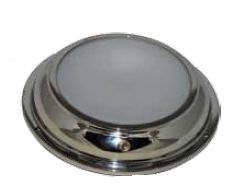
To see exactly whats in play, consider the role of the innocuous 15- or 20-watt incandescent lamp. It may not seem like a power-hungry villain trying to drain the boat batteries, but a closer look at total cabin illumination tells a different story. Just tally up the nightly net effect of five of these lights, or better yet, simply turn to the amp meter on the electrical panel, and note the 8- to 10-amp current draw. Over a five-hour period, these five cabin lights account for 40 to 50 amp hours of energy use. Substituting equally bright, LED cabin lights can result in a five- to six-fold reduction in overall power consumption. So, by transitioning to LED technology, the five cabin lights, delivering equivalent illumination, will consume approximately 7.5 amp hours over the same five-hour period of illumination. Its no wonder why so many sailors and boat builders are swapping out older incandescent lighting for the LED alternative.
However, as we saw in our test, not all LED lights are created equal. And in some cases, switching over to LED can have unintended consequences, ranging from a nauseating pale-blue color to radio frequency interference (RFI) that can disrupt or impair radio communication by VHF or single sideband (SSB) radio.
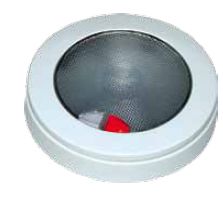
What We Tested
The test group of 27 interior light-emitting products was anything but homogeneous. The common factor was that all were examples of LED illumination, and by grouping products into some logical subsets, we were able to make some apples-to-apples comparisons. In order to streamline the comparative process, we broke up the 26 LED cabin lamps and lights (12- and/or 24-volt DC) into five specific groups-small dome lights, large dome lights, bulkhead-mounted reading lights, non-dome overhead lights, and special-use lamps. The most uniform type was the bulkhead-mounted reading light, designed to deliver a relatively narrow beam of illumination.
The switches used in the test lights varied from traditional toggles and handy rockers to touch-sensitive and variable dimmers that allowed the bulb to be completely sealed. Some of the products incorporated red (or blue) illumination and high/low level switching. Testers unanimously agreed that the trend toward higher-color temperature lights, with a bluish hue, was distracting. On the plus side, the growing number of waterproof units make these lights good candidates for forepeak and locker illumination-where hue is less important than luminance.
This article focuses on the small and large dome lights we tested. We will be looking at the bulkhead reading lights, overhead lights (wide and narrow beam), and special use lights in an upcoming issue. Note that some of the overhead lights from popular brands such as Alpenglow and Imtra are fine substitutes for dome lights in many cases; however, we stuck strictly with dome designs for this article.
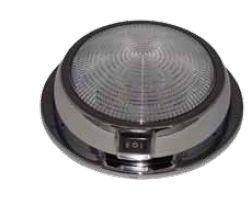
How We Tested
The first step in this evaluation process involved a look at the design and construction of the fixture and how they would be installed aboard a sailboat. Next, we set up each unit in a jig that controlled the angle of the fixtures and carefully measured luminance, field of radiance, switch functionality, and radio frequency interference-all key factors that influence the quality of onboard lighting.
One of the first things we noted was that the output ratings in lumens-a specification commonly used by light manufacturers to compare their products-did not adequately define the usefulness of the light supplied by any given lamp. Lumens equal the total amount of light emanating from a visible light source, but fail to address the quality of the light actually hitting the surface. Just because a fixture and bulb delivers a certain amount of light, doesn’t mean that light is going where we need it. For example, we found a huge difference in how efficiently lamp lenses diffuse light and eliminate unwanted hotspots. By looking at the Value Guide with this article, you can see that several lights with higher stated lumen outputs rated mediocre in terms of useful light.
Rather than focus on total lumen output, we found that we could obtain a better measure of specific area illumination by shining each light on an 18-percent neutral grey surface and using a Pentax spot meters exposure-value (EV) scale to determine luminosity in lux. We then double-checked these readings with a Gossen Luna Pro-F light meter equipped with a spot meter attachment. This approach gave us a chance to read intensity and uniformity of the full spread of the beam-noting hotspots, darker regions, and unwanted projected shapes.
At the conclusion of our testing, we crunched the numbers, added in the subjective ratings given for reading text using the beam, effect on FM radio signals, and the construction quality of the housing itself. A rating of Excellent was given to the superior product in this test group. A Very Good rating delineated above-average products, while Good was a solid middle-of-the-fleet ranking. Fair and Poor ratings indicated a shortfall in performance or a housing that was just too flimsy for marine use.
Small Dome Lights
Small dome lights are a good choice for overhead lights at the nav station or in the galley, engine room, head, or locker, where the area to be illuminated is relatively small.
Dr. Led
Dr. LEDs Mars dome light is a bright light source and a featherweight option for racers counting grams. The three-way rocker switch is covered with a boot, and the chrome-finish, all-plastic construction is durable. The textured, polycarbonate diffuser helped spread the LED light intensity, but there were noticeable ring-shaped hotspots projected onto the surface. RFI was very well suppressed, and the simple red or white illumination option works well.
Bottom line: The Dr. LED is better built than the other plastic light in this group, the MISEA, which sells for about half the price. It is one of the least expensive red/white lights in our comparison.
Sailors Solutions
Sailors Solutions 5.5-inch dome light is a well-built, stainless-steel, dual Sensibulb light. The plastic diffuser does a fair job of buffering hotspots and spreading the beam, but the LEDs are close to the lens, and the design does not feature a conical reflector. The unit we tested had a notable effect on VHF reception, completely shutting down weather-channel reception on a handheld VHF from 2 feet away.
Bottom line: This is a durable housing and efficient light, but the VHF interference will be an issue for some installations.
West Marine
The 4-inch, Platinum Series West Marine dome light delivered very even illumination thanks in part to a well-designed, frosted diffuser thats part of the sealed waterproof unit. A handy bezel ring acts as both a toggle to select white or red light and also access a dimmer feature for either color.
Bottom line: This compact, low-profile lamp gets hotter than most, but the current and light intensity readings did not show any adverse effect.
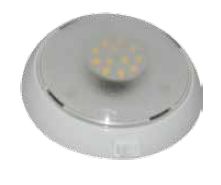
Larger dome lights
The larger dome lights we tested ranged from fairly flimsy to watertight.
Misea
The MISEA Corona incorporates an all-plastic housing with three red and 12 white G4 LED light sources. The lightweight lamp is energy efficient, consuming 0.2 amps in the white-light mode. The SPST rocker switch acts as an on/off selector, but another switch or breaker must be cycled if the red light feature is to be selected. Theres a noticeable hotspot in the center of the plastic diffuser, but the light reaching the surface is fairly evenly dispersed. RF interference was in the midrange of the units tested.
Bottom line: The housing is hardly top-of-the-line, but this is by far the least expensive dome to meet our minimum standards, thus it earns the Budget Buy pick.
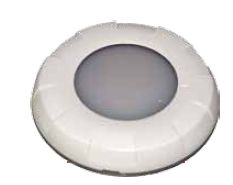
West Marine
West Marines 7-inch, stainless-steel dome light is a nicely fabricated traditional housing with an effective glass diffuser. The LED array casts a very even, wide angle beam at a moderate luminance, consuming only 0.2 amps. The RFI suppression is superior, and the on/off rocker switch is convenient.
West Marines Platinum Series 6-inch, bi-color (white/blue), sealed dome light is energy efficient, and the molded-plastic diffuser does a very good job of evening out the light intensity across the wide angle beam. There was a 0.2-amp current draw on full power white, and as the digital dimmer lowered output, the current draw dropped accordingly. Testers were not fans of the blue option, and we recommend sticking with a red/white bi-color option. The sealed circuitry did heat up during operation, so this would not be the best choice of lights when it comes to brightening up a hot engine room.
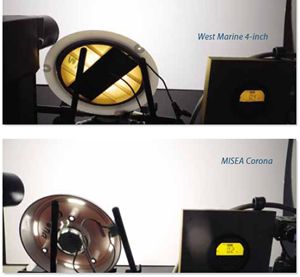
The low-profile dome features touch controls and dimmer features for both colors.
Bottom line: Sealed contacts and good engineering details make the West Marine 7-inch lamp a serious contender in the no-frills category. It earned the Budget Buy pick.
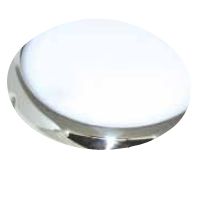
Hella
Hellas EuroLED Touch 150 is a sealed, impact-resistant, nylon-reinforced lamp with touch-switch technology. It comes in a 5.75-inch disc shape ready to be flush or pedestal mounted.
Our testers classified it as a specialized dome light with waterproof characteristics and a relatively narrow beam width. Its a bright, energy-efficient light and when touch-toggled to its highest setting, it consumes only 0.3 amps. The combination red/white illumination and the lights water-tight integrity make it a good choice for a wet forepeak or wherever seawater is likely to intrude. Its beam is tight, not quite a spot, but just the right balance.
Bottom line: Recommended for brightening a small cabin, large sail locker, or head compartment where shower spray can invade unsealed electrical circuitry.
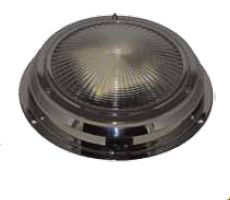
Cruising Solutions
Cruising Solutions 6.5-inch dome light uses a 23-LED array with a triple emitter driver, mounted in a stainless-steel housing. Its 220-lumen rating delivered bright, even 6.2 EV lighting at 2.5 amps-the brightest illumination in the large dome class. Unfortunately, the unit shut down VHF weather radio reception from 2 feet away. The unit price and performance are attractive and installation in fore or aft cabins would likely nullify the concern about RF interference.
Bottom line: RFI issues overshadow the sheer light output in this dome.
Imtra
Imtras Gibraltar Bi-color with a three-way switch is a lesson in how cabin lights should be made. The frosted glass diffuser wont craze with time. The conical reflector shapes the light into a better-controlled beam, and the wiring connections and circuitry show true attention to detail. The illumination is even, the RF hiss is low, and the simplicity of switching makes sense.
This is a fixture that can be easily repaired or upgraded in the future, and such attributes are of value to long-term cruising sailors. The only downside is the high cost.
Bottom line: A high-quality, versatile light that we wish we could afford, the Imtra is the clear Best Choice in the dome light category for those with the budget to accommodate it.
Conclusion
During our tests, some important observations rose to the surface. First of all, the best cabin lighting combines LED light sources with good constant voltage controllers, properly angled reflectors, and optically efficient diffusion lenses. In addition, the housing needs to be built sturdily enough to handle the wear and tear of the marine environment. Lumens count, but when it comes to light for reading or general cabin illumination, overall evenness, color temperature preference, and how the beam width fits the area to be illuminated count even more.
An important finding was that RF interference wasnt just an issue of the proximity of a radio to a poorly suppressed LED driver, but in some cases, we noted that the interference caused by a poorly suppressed light was actually impressed into the DC wiring and propagated throughout the boat. In such cases, putting the VHF handheld antenna near a 12-volt DC power lead well away from the light would interrupt radio reception.
When testing was done, we gave generic nods to warm-tone white LEDs over the cooler (bluer) alternatives; our switch preference remains high-quality rocker designs; and when it comes to overall rankings, the higher-cost lights from Imtra and Hella lead the pack. That said, we found value in the mid-range and some low-priced lights worth considering.
